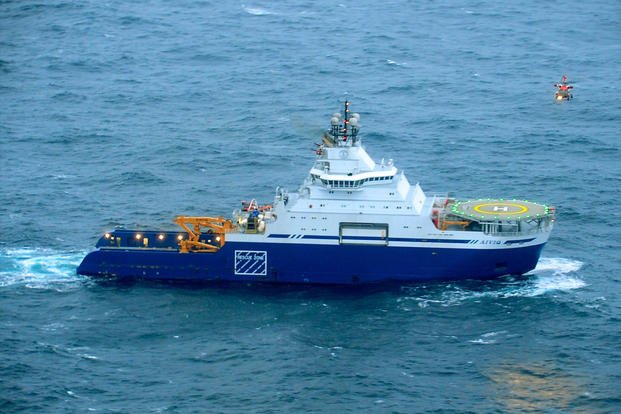A commercial icebreaker will join the Coast Guard’s fleet by the end of the year, officials told lawmakers during a House subcommittee hearing Thursday on U.S. efforts to expand presence in the Arctic.
The Aiviq, an oil exploration support vessel that has worked in the Arctic and Antarctic regions, is currently in Pascagoula, Mississippi, where it is being adapted for Coast Guard use. According to Vice Adm. Thomas Allan, the Coast Guard’s deputy commandant for mission support, its hull is now “a quarter Coast Guard icebreaker red” and the service has plans to take it out to determine what “capabilities it has.”
“We’re making tremendous strides in that with the owner,” Allan said in the hearing, referring to Offshore Service Vessels. “We will be on board soon to finalize negotiations, looking at how we, in the short term, crew that with commercial operators.”
Read Next: Navy Shutters Premier East Coast Substance Abuse Program Amid Staffing Shortages
The Aiviq, which will be homeported in Juneau, Alaska, is expected to be in the Arctic region in early to mid-2026, he added.
The Coast Guard has two ocean-going icebreakers, the Healy, which operates in the Arctic, and the Polar Star, a 48-year-old ship that is the only one capable of breaking heavy ice in Antarctica. Efforts are underway to build three new vessels — the Polar Security class — with an aim to start construction of the first, the Polar Sentinel, by the end of the year, Allan told the House Transportation and Infrastructure Committee’s Coast Guard and maritime panel.
A memorandum of understanding signed Nov. 13 between the U.S., Canada and Finland should help accelerate construction of the Polar Security cutters, according to the administration. The agreement aims to increase cooperation to improve their construction by leveraging the strength of the American shipbuilding industry with the polar expertise of the Canadian and Finnish work forces.
This fall, China and Russia held their first-ever joint patrol of the Arctic region, coming as close as 12 nautical miles to the Alaska coast in October, traversing through the Bering Strait just outside U.S. territorial waters off the Seward Peninsula.
And several times this year, Chinese and Russian bombers have flown in international airspace just off Alaska in what is known as the Alaska Air Defense Identification Zone, prompting the North American Aerospace Defense Command to scramble U.S. and Canadian fighter jets.
The Department of Defense’s 2024 Arctic Strategy calls for increased presence in the region as the climate shifts, warming up the seas, leading to a reduction in ice and increased traffic in the area, including activity by potential adversaries.
According to the strategy, the plan is for the U.S. to take a “monitor and respond” approach, having robust intelligence collection in the region, cooperation with regional allies and deterrence through presence.
The Coast Guard commercial icebreaker program is part of that plan, with the Aiviq providing patrol operations starting in 18 months.
“I don’t think we are looking to make tremendous investment on the vessel going forward,” Allan said. “We need it for presence and to be able to operate.”
The Aiviq will be homeported in Juneau at a former National Oceaneographic and Atmospheric Administration pier that “needs a lot of maintenance, a lot of work,” but getting the ship to the region is a priority, Allan told the panel.
“We are at least going to make sure we have a presence with that vessel,” Allan said.
The Polar Security cutters are slated to be homeported in Seattle, where the Polar Star and Coast Guard cutter Healy, the service’s only medium polar icebreaker, are currently assigned.
The Coast Guard cutter Healy suffered a fire in August but was repaired and quickly returned to the region in October to conduct an expected 10-week patrol.
Rep. John Garamendi, D-Calif., told Allan and Vice Adm. Peter Gautier, deputy commandant for operations, that they should not shy away from requesting the funding the service needs to improve the force.
“You’ve got to be very clear with us, your unfunded priority requirements and why they are critical. Don’t be timid … we want you to be bold,” Garamendi said.
Related: Nordic Allies Help Navy Improve Ship Ops in Icy Waterways as Arctic Competition Heats Up
Story Continues
Read the full article here


